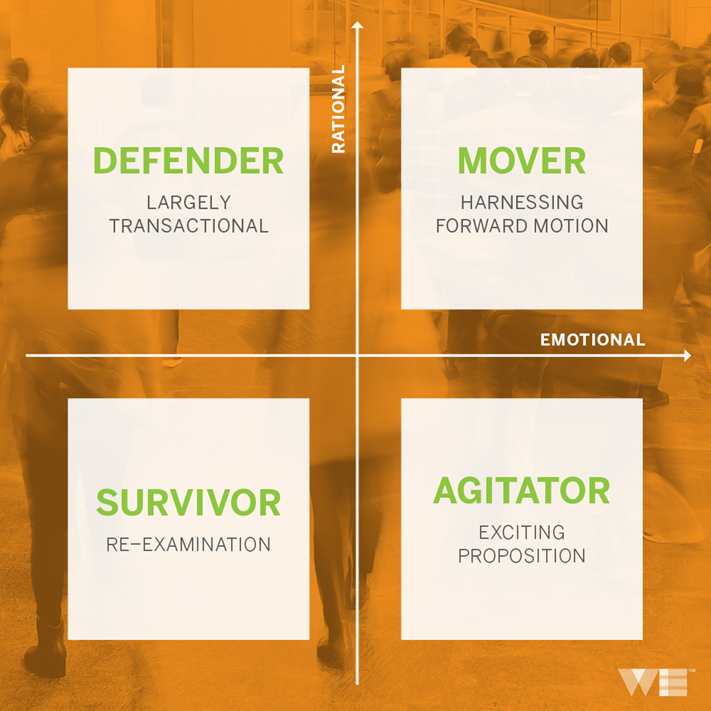
WE in Holmes Report: Innovation, Impact, Integrity
Innovation, Impact, Integrity: Elevated Consumer Expectations For Computing Devices Brands
It’s an incredible time, confusing and fast changing. But in many ways we are living today with the full power of technology we were always promised.
We live in an always-on world, and we rely on our devices to help us navigate it. We love our iPhone, iPads, Surfaces and Galaxies, and we expect a lot out of them. They need to put work and play at our fingertips and do it seamlessly. That’s what I expect from my devices. And it turns out most consumers share my high expectations.
At WE, when we look at computing devices brands, we see a category that’s driving change globally and impacting every part of our lives. The computing devices category (which includes smartphone, tablet, laptop and desktop computer brands, and related software and hardware) gave most consumers their first look at the technological breakthroughs reshaping every industry on the planet. And it will give them their first look at predictive tech, apps driven by machine learning, and wearables that integrate seamlessly with our busy lives.
And now that our devices are such a huge part of our day-to-day, consumers want more than great products and innovative technology. They hold their computing devices brands to a higher standard. They see them not just as innovators, but as drivers for social good, integrally woven into the fabric of global society.
An industry in motion
WE Communications’ recent Brands in Motion study put some numbers around this new level of consumer expectation for computing devices brands. We looked at 10 rational and 10 emotional drivers of consumer opinion across eight industry categories (including computing devices) in six countries: Australia, China, Germany, the U.K., the U.S. and South Africa. More than 3,000 consumers and 1,000 B2B decision-makers were surveyed in each market.
Our diagnostic tool, the Motion Matrix, looked at the rational and emotional scores and mapped the perception of industries and brands against four quadrants: defender (high rational score, low emotional score), survivor (low scores in both rational and emotional), mover (high scores in both rational and emotional), and agitator (low rational score, high emotional score).

With high scores in both rational and emotional drivers, the computing devices category was a mover in every market. Nearly three-fourths of respondents in Australia, China, South Africa and the U.S. responded that they loved computing devices. In all markets, over 67 percent of respondents indicated that their overall impression of computing devices brands is “amazing” (with a notable 83 percent in South Africa). Consumers also viewed computing devices as innovative, with the majority of respondents in every market indicating that they see the category as “cutting edge.” Majorities in all markets — including 81 percent of U.K. and U.S. respondents — also declared that they “can’t live without” computing devices.
Not entirely surprising, considering the proliferation of smartphones and tablets. But the Brands in Motion research also revealed that brands perceived as cutting edge are more likely to be seen as having a positive social impact and contributing to the common good. Nowhere is this more noticeable than in the computing devices category.
Consumers expect more than cutting edge
A majority of respondents in every market felt that computing devices brands had a positive impact on society. In China, 77 percent of those surveyed said these brands were out for the common good (note that respondents in China consistently ranked all categories as more socially impactful compared with respondents in other markets).
Executive behavior was also a strong influence on consumer perception. An average of 56 percent of respondents across all markets indicated that the actions of the executive leaders of a computing devices company would exert a strong influence on their decision to support the brand. German respondents were the most likely to tie C-suite behavior to their willingness to support a brand (65 percent). Americans were the least likely (47 percent).
Respondents also said they were very likely to publicly shame a company if it’s under attack. An average of more than 4 out of 5 respondents across markets said they would join in the public shaming if a company stepped out of line. Respondents in China were the most forgiving (34 percent said they would publicly defend them). German respondents were the least (86 percent said they’d join in the shaming).
Technological innovation meets social responsibility
Managing consumer expectations will mean pairing innovative products with equally innovative approaches to social impact and responsibility.
Bottom line: Today’s brands need to do more than make the best products on the market. If they can’t also meet consumer expectations around social good and responsibility, they’re unlikely to lead in their category or win with today’s consumers — and they’re going to get hit harder when something goes wrong.
To meet those expectations, computing devices brands will need to demonstrate real, tangible corporate social responsibility. They’ll need to invest in executive communications plans that make social impact a plank in their platform. And they’ll need to identify and share authentic stories about how their products are making the world a better place for today’s consumers.
It’s an incredible time, confusing and fast changing. But in many ways we are living today with the full power of technology we were always promised. It’s messy and there’s no guarantee that the best brands today will have the momentum to stay the best in the future. Especially when that future is less dependent on the device and more dependent on how it can make the world a better, more connected and more equal place.
By Kass Sells, president, North America, WE Communications

